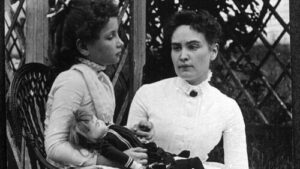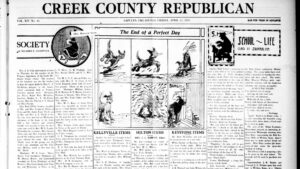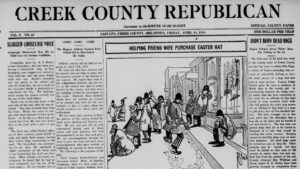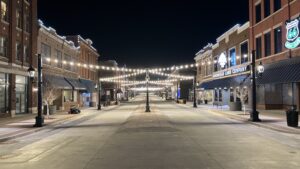Rachel Whitney, Curator, Sapulpa Historical Museum
The Telegram: “‘Mrs. Anne Macy unable to keep engagement at Sapulpa. Has acute laryngitis. Dr. Salwin afraid will have to cancel all engagements unless she takes rest and treatment. Deeply regret not speaking for you. Will come back in spring if you wish. Will if long jump is necessary. Miss Helen Keller sends regrets, too. -Tolly Thompson, Sec.’”
In February 1915, Sapulpa’s Symphony Club held an engagement where a special guest would be featured. “The ladies of the Symphony Club kindly make the request that no small children be brought to the Helen Keller lecture. The capacity of the house is limited and it is necessary to have absolute quiet in order that all may hear her. Tickets for the Helen Keller lecture can be secured from any member of the Symphony Club or at Uden’s Book Store. Subject, ‘Happiness.’ Doors open at 7pm Feb. 23, 1915.”
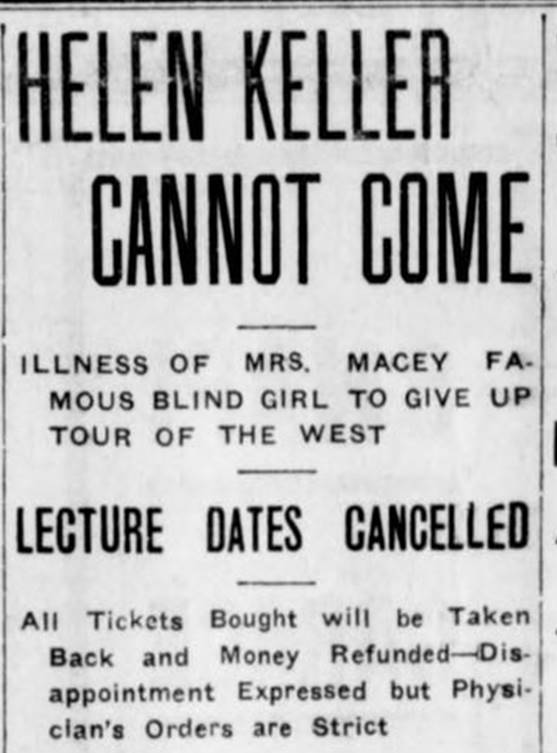
Sadly, this event did not take place. The telegram was received on February 22, 1915. The headline simply read “Helen Keller Cannot Come.”
Helen Adams Keller was born in 1880 from Alabama. “At 19 months old, Keller contracted an unknown illness described by doctors as ‘an acute congestion of the stomach and the brain.’” Today, it is possibly viewed as meningitis.
“The illness left Keller both deaf and blind.”
At this young age, only one person could understand Helen: “Keller was able to communicate somewhat with Martha Washington, who was two years older, and the daughter of the family cook, and understood the girl’s signs. By the age of seven, Keller had more than 60 home signs to communicate with her family, and could distinguish people by the vibration of their footsteps.”
Around this time, the family met with Alexander Graham Bell, as he was working with deaf children; he would advise the family to meet with Perkins Institute for the Blind in Boston. Here, the family met Anne Sullivan, a former student at the Institute, who would become Helen’s instructor.
Anne Sullivan Macy was born in 1886 from Massachusetts. “At age five, Sullivan contracted trachoma, an eye disease, which left her partially blind and without reading or writing skills. She received her education as a student at Perkins. Soon after graduation at age 20, she became a teacher to Helen Keller.”
“It was the beginning of a nearly 50-year-long relationship.”
On March 5, 1887, Anne moved into the Keller house and began teaching Helen how to “communicate by spelling words into her hand, beginning with ‘d-o-l-l.’” And by the next month, another word, ‘w-a-t-e-r’ and Anne would run water over her hands while signing the word.
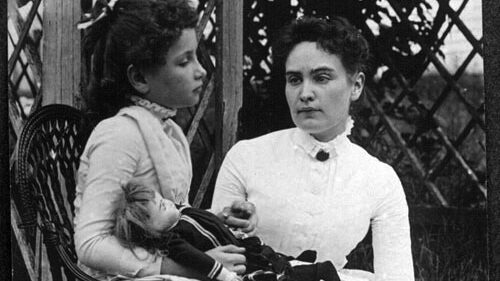
Helen would recall this very moment of breakthrough: “I stood still, my whole attention fixed upon the motions of her fingers. Suddenly I felt a misty consciousness as of something forgotten-a thrill of returning thought…The living word awakened by soul, gave it light, hope, set if free!”
Helen would attend Perkins by 1888, then Wright-Humason School for the Deaf by 1894. In 1896, Helen entered Cambridge School for Young Ladies; and in two years, to Radcliffe College of Harvard University.
Helen’s schooling and education became important and many people took notice in her response to learn and share. “Her admirer, Mark Twain, had introduced her to Standard Oil magnate, Henry Huttleson Rogers, and his wife Abbie, who paid for her education.”
At the age of 24, in 1904, Helen Keller graduated from Radcliffe, “becoming the first deafblind person to earn a Bachelor of Arts degree” in the United States.
Helen Keller was an author, advocate, and a lecturer.
As an author, she “wrote a total of 12 published books and several articles.” She provided her first piece at age 11, in 1891. At age 22, Keller published her autobiography, ‘The Story of My Life’ in 1903. And in 1907, in her articles, she would bring awareness to the many cases of childhood blindness, a prevention through “washing the eyes of every newborn with a disinfectant solution.”
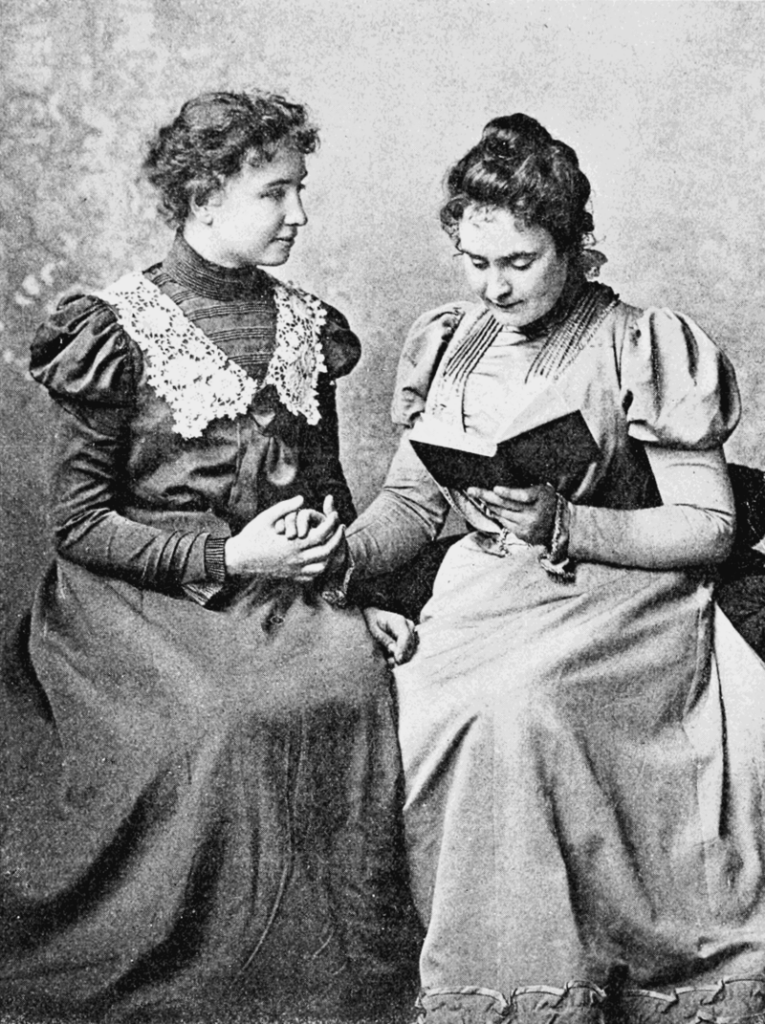
“She was an advocate for people with disabilities.” Helen did not keep still; she traveled. “She traveled to twenty-five different countries, giving motivational speeches about Deaf people’s conditions.” In 1915, the Helen Keller International organization was formed to “devote to research in vision, health, and nutrition.” In 1920, Helen would also form the American Civil Liberties Union, “providing legal assistance where it considered civil liberties at risk,” and traveling to over 40 countries to show support for civil rights.
As a lecturer, she would share her motivational speeches. These motivational speeches were heard not only heard around the world, but in small towns like Sapulpa, Oklahoma. In 1915, Helen Keller and Anne Sullivan had to cancel the tour.
However, it would be rescheduled. Helen Keller would “deliver her lecture, ‘Happiness’ at the South Methodist Church” this week in Sapulpa history, on April 23, 1915.

“Helen Keller Tonight – The Symphony Club has gone to considerable expense to secure this famous woman. You will be well paid if you attend the lecture.”
“The Helen Keller lecture at the South Methodist church last evening was one of the most brilliantly successful affairs ever brought before Sapulpa audience. The house was packed, the music very excellent and the talk by Mrs. Macy highly appreciated while the lecture itself by Miss Keller, was wonderful beyond all expectations.”
Anne Sullivan, or as Mrs. Macy now, began the night by explaining the history of the schooling and techniques of Helen Keller’s communication. “Helen Keller’s advancement from the depths of utter darkness of the mind to what she is today-intelligent, educated, and one of the most highly cultivated women of the modern age.”
The newspaper article gave a great description of how it felt to experience, not only the lecture, but knowing how important this moment would be in history:
“Helen lived out of doors and learned from all growing things, her active mind demanding an explanation for everything and volumes could be filled with her quaint sayings and amusing questions during the first sixteen months. Her own definition of the words ‘patience’ and ‘happiness’ are examples. Patience means ‘sit still a long time and wait.’ Happiness means, ‘hop, skip, and jump and eat very long bananas.’
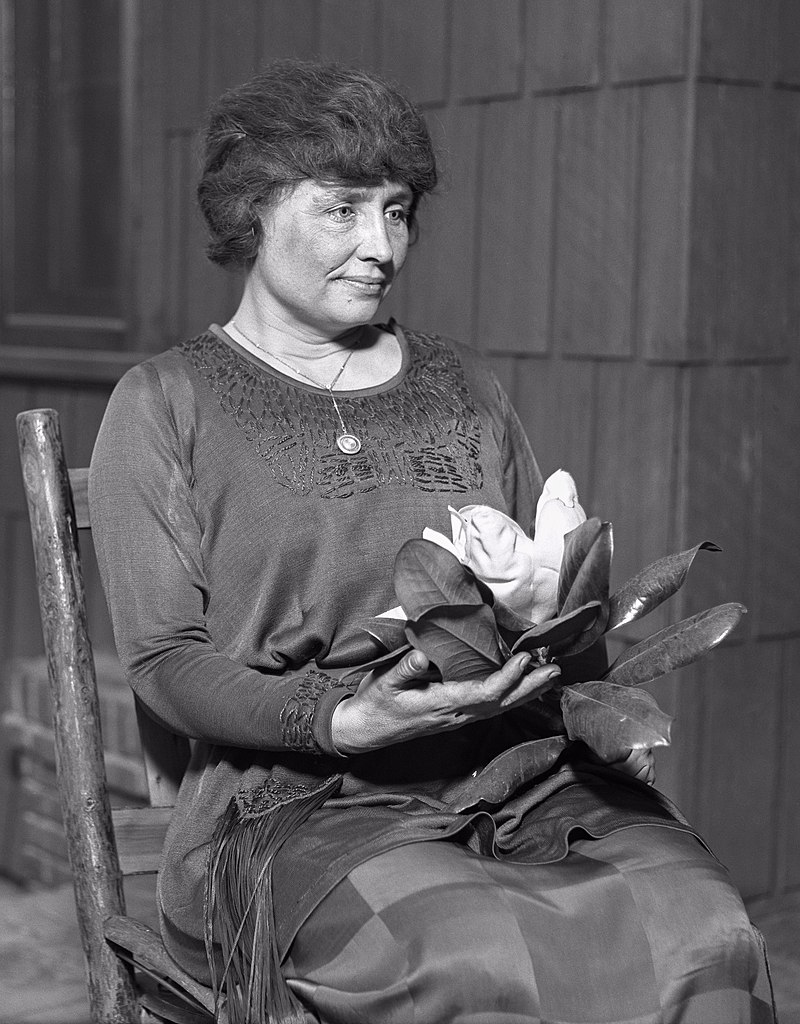
“She was not satisfied, however to talk only upon her fingers but insisted that she wanted to talk with her mouth.
“The task looked hopeless but she was taught the rudiments of articulation and by imitating the vibration of the vocal chords and the movements of the tongue in pronunciation she learned to articulate and at last after long weeks of arduous practice one day said triumphantly, ‘I am not dumb now.’
“She wanted to learn to speak so that she could go to college and at last her will prevailed and she entered Radcliff, passing the examination without condition, writing her examinations upon her typewriter. She went through college in four years, and during that time did not have the help of her teacher, but won her degree against almost overwhelming obstacles.
“When Miss Keller appeared to deliver her lecture she was greeted with a perfectly deafening round of applause. She is a remarkably sweet girl of medium size, wavy brown hair, and dark eyes, while her sweet, appealing smile won the hearts of everyone.
“Her lecture while not perfectly intelligible to the audience because of the difficulties under which she labored in learning to speak was understood as a whole, by those who heard the voice and could see the expressions that accompanied it.
“She was asked if she knew when her audience applauded and she replied that she did because she had ‘ears in her feet.’ She knew when they laughed because she could ‘feel the laughter in the air.’
“She is a suffragist and an enthusiastic socialist. She loves little children, and flowers, especially violets, and her favorite book is the Bible. She keeps in touch with the world by magazines printed in the Braille lettering, and has a large library in French, German, and English, printed in Braille. She loves nothing so much as argument and discussion and has the most responsive sympathies.”
The night ended with a boisterous round of applause and many thanks.
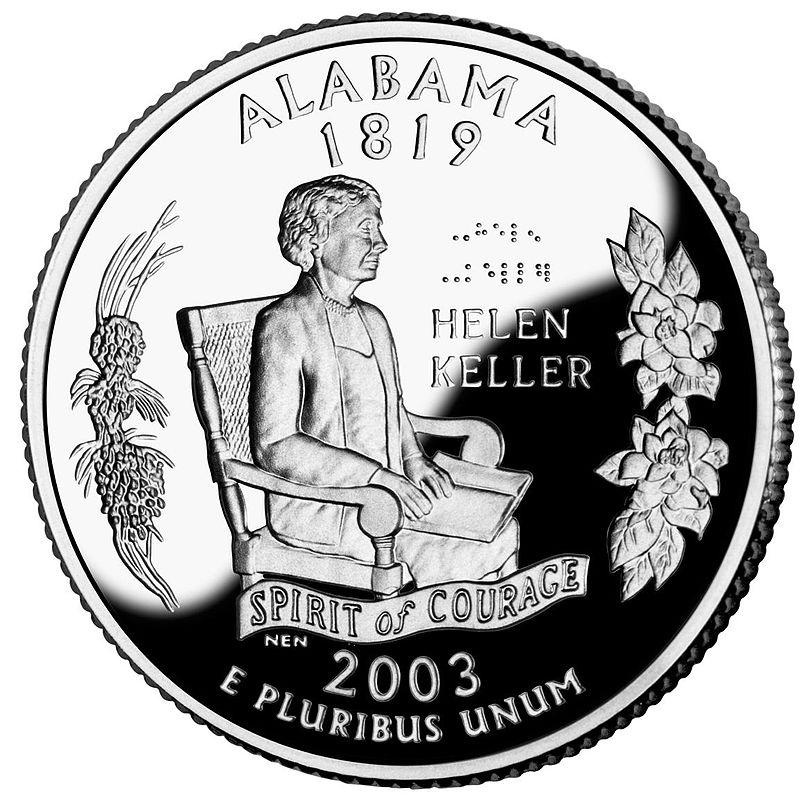
Anne Sullivan Macy would pass away at age 70 in 1936. In 1956, “the director’s cottage at the Perkins School was named the Keller-Macy Cottage. In 2003, she was inducted into the National Women’s Hall of Fame.”
Helen Keller would pass away just weeks shy of her 88th birthday in 1968. “On September 14, 1964, President Lyndon B. Johnson awarded her the Presidential Medal of Freedom. In 1973, Helen Keller was inducted into the National Women’s Hall of Fame. In 1999, Keller was named one of Time magazine’s 100 Most Important People of the 20th Century. In 2003, Alabama honored its native daughter on its state quarter,” which is the only state quarter to feature braille.
(Sapulpa Herald, February 20, 1915, February 22, 1915, April 14, 1915, April 24, 1915; Creek County Republican, April 23, 1915; Wikipedia)


